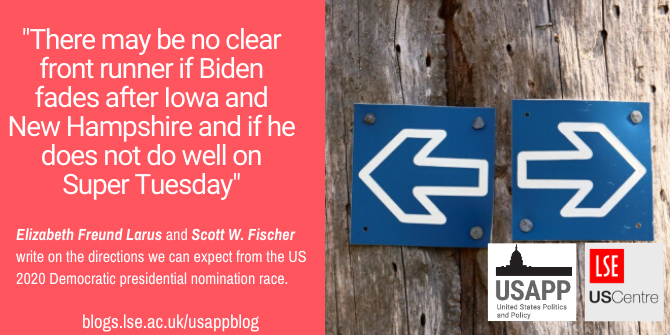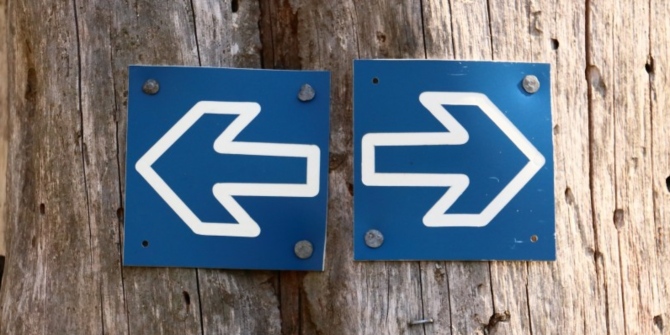
 While impeachment is the talk of the town in Washington DC, we are only months away from the first presidential primary contests. Elizabeth Freund Larus and Scott W. Fischer write that, on the Democratic side, the current field is at a historically large 17 candidates, with two late entrants joining the field in recent weeks. They comment that the new candidacies are significant in that it is relatively late to jump into a race so close to the first contests. While former Vice President Joe Biden has been the frontrunner for most of the year, they caution that the popularity of Senator Elizabeth Warren and Mayor Pete Buttigieg show that there are cracks in his lead which may continue grow in the lead-up to the Democratic convention.
While impeachment is the talk of the town in Washington DC, we are only months away from the first presidential primary contests. Elizabeth Freund Larus and Scott W. Fischer write that, on the Democratic side, the current field is at a historically large 17 candidates, with two late entrants joining the field in recent weeks. They comment that the new candidacies are significant in that it is relatively late to jump into a race so close to the first contests. While former Vice President Joe Biden has been the frontrunner for most of the year, they caution that the popularity of Senator Elizabeth Warren and Mayor Pete Buttigieg show that there are cracks in his lead which may continue grow in the lead-up to the Democratic convention.
The US presidential election is now less than a year away. And while President Trump is almost certain to be renominated by the Republican Party, the Democrats face a much bumpier road to deciding their own nominee to be Trump’s opponent at their party convention in July 2020. But how will we get from here to there over the next seven months?
The Process
The two standard methods for choosing delegates to the national party convention are the caucus and the primary. Voters in caucus states show up at a designated place, and after much discussion, vote for delegates who support their favorite candidate. In a primary, voters go to the polls to indicate their preference for their party’s candidate. In either caucus or primary, participants vote for delegates who will support their favored candidate at the national party convention to be held in the summer.
The 2020 convention delegate selection process begins with the Iowa Caucuses on February 3, followed a week later by the New Hampshire Primary. Candidates historically try to win the most delegates at these primaries to establish themselves as frontrunner. The next major event is the March 3 “Super Tuesday” when 15 states and Democrats Abroad hold their primaries and caucuses. This year, the two most populous states, California and Texas, will also hold their primaries on Super Tuesday. More than one-third of the US population is expected to vote that day. Fifteen other jurisdictions will hold primaries and caucuses later that month. Roughly two-thirds of the delegates will have been allocated by the end of March. It is crucial for a candidate to cement his or her lead by then to get the support of delegates at the upcoming nominating convention.
The Frontrunners
Since May, the front runners have been former Vice President Joe Biden, Senator Bernie Sanders (VT) and Senator Elizabeth Warren (MA). In the national-level polls, Biden is leading with 29.8 percent, with Sanders at 19.5 and Warren at 18. Sanders and Warren were trading 2nd and 3rd positions until Warren began surging in September. Warren overtook Biden in early October, but her numbers have peaked since then. Sanders narrowly reclaimed 2nd place in the most recent poll average. Many Americans view Biden as the centrist, establishment Democrat candidate. Despite his front runner status, Biden struggles with fundraising, momentum, and a lack of enthusiasm for his candidacy. Conversely, Sanders and Warren are competing against each other as the candidate best representing the progressive-populist wing of the Party. Sanders is a long term socialist and not a formal member of the Democratic party. He sits in the Senate as an independent, but caucuses with the Democrats. Warren is unapologetic about her desire to steer the Party leftward.

“733252” by pxhere is CC 0 Public Domain
One liability shared by all three front runners is their age, with Warren being the youngest at the age of 70. Although there have not been any reports of Biden or Warren having major health issues, Sanders recently had a heart attack. The Democratic Party is beginning an era of generational change, but the old guard has been slow to recognize younger members and their views.
2nd Tier Chances
Polls can be misleading. Polls reflect public opinion, but the race is really for the maximum number of delegates to the national party convention. The race for delegates is dependent on how the candidates perform in each state. Over the past two months, Warren and Biden have lost support in the opening states of Iowa and New Hampshire. The main beneficiary of this has been the most viable of the current second tier of candidates, 37-year-old Pete Buttigieg, the mayor of South Bend, Indiana, who has 7.8 percent in the most recent poll average. Buttigieg is competing for the centrist lane criticizing Sanders and Warren has having ideas that might be great on paper but have little chance of being passed into law. A Sanders or Warren presidency would continue gridlock in Washington and further polarize the nation. Despite his lack of national experience, Buttigieg currently leads in both Iowa and New Hampshire, a factor that has given him favorable national press. If he can pull off a win or respectable finish in either state, it could boost his national poll numbers.
Since September, Buttigieg has risen 16 points among Iowa likely caucusgoers with 25 percent, ten points ahead of Biden, Sanders and Warren, who are in a virtual tie for second place. Comparatively, Warren, who led in the September poll, has lost seven percent since while Biden has lost five points. Buttigieg has made similar gains in New Hampshire. In the most recent statewide poll, Buttigieg won support from 25 percent of likely primary voters compared to 15 percent each for Biden and Warren, with Sanders running 4th with 9 percent. Two months ago, Buttigieg was in fourth place with 10 percent in the same poll with Warren and Biden in a virtual tie for first.
A possible honorable mention spot for current second-tier candidates is 77-year-old businessman and former New York City Mayor Michael Bloomberg, who currently is in seventh place in the average of polls with 2.8 percent. Bloomberg did not formally enter the race until November 24th so there are not yet any polls as that reflect his status as an official candidate. Bloomberg is also pursuing the centrist lane as a Biden alternative. He is portraying himself as a non-ideological billionaire whose personal wealth would uniquely counter that of President Trump in the upcoming fall campaign. He began his campaign by reserving almost $35 million for television commercials, far outdistancing the current advertising budgets of other campaigns. Whether he can make the case for his viability remains to be seen, but his deep pockets will allow him to make his case to voters between now and the Iowa and New Hampshire contests.
A President from the Left?
With some minor fluctuations, the United States has been a 50/50 nation divided roughly equally between Democrats and Republicans for at least two decades. This brings up the question that given the relatively high unpopularly of President Trump amongst Democrats and some independents is the country ready to accept a president from the left wing of the Democratic Party. The conventional wisdom says no; however, conventional wisdom has been wrong in the past as evidenced by the election of the overtly conservative Ronald Reagan in 1980. Nonetheless, despite enthusiasm of younger voters for the candidacy of Bernie Sanders, we do not see this trend yet having a critical sustainable mass. President Trump may have unusually high negative poll numbers, but those numbers are based more on his governing style and less on his policy views. His numbers have not necessarily been translated into support for Democrats, let alone support for the leftwing of the Democratic party.
Joe Biden continues to be the front runner for the Democratic nomination; however, his support is not deep and significant numbers of Democrats are not enamored with him as evidenced by the surging of Pete Buttigieg in Iowa and New Hampshire and the late entrance of Michael Bloomberg into the race. The runup to these contests will be crucial to see if Biden can continue as frontrunner.
Since 1976, all Democratic nominees have won either or both Iowa or New Hampshire except for 1992 when Iowa was not really contested due to a “favorite son” candidacy and a senator from a neighboring state won New Hampshire. If Biden does not do reasonably well in these contests, the question will become what impact will this have on his candidacy? Will voters in the subsequent contests, especially those held on Super Tuesday, continue to support Biden?
This is where the Democratic Party national convention becomes important. Once the primaries are over, the Democratic Party will hold a convention in July 2020 in Milwaukee, Wisconsin. Nearly 4,600 convention delegates will vote for the Democratic candidates. The delegates vote in a series of ballots until one candidate wins a majority. Of the delegates, 3,836 will be pledged to vote for the candidate who won the most votes in their respective states. To win nomination on the first ballot, a presidential candidate must win a majority of pledged delegates (an estimated 1,919 votes). The remainder nicknamed “superdelegates,” are typically government officeholders or party officials who have a strong party influence and are not pledged to any candidate. As a result, they are a wild card that can sway the convention vote because of their influence. To limit the influence of these elite ‘superdelegates’ Democratic party activists passed a rule that superdelegates cannot vote on the first ballot. The addition of superdelegates on subsequent ballots increases the number a candidate needs to garner to just over 2,200.
What to Expect
What does this nomination process matter? There may be no clear front runner if Biden fades after Iowa and New Hampshire and if he does not do well on Super Tuesday. If that happens, superdelegates may become a determining factor in the nomination. Superdelegates are establishment Democrats, who will likely fear that a candidate from the progressive left wing, like Warren or Saunders, will cost them the White House. They will likely support a centrist like Buttigieg or Bloomberg as a best bet against Trump.
Please read our comments policy before commenting.
Note: This article gives the views of the authors, and not the position of USAPP – American Politics and Policy, nor the London School of Economics.
Shortened URL for this post: http://bit.ly/344mapW
About the authors
 Elizabeth Freund Larus – University of Mary Washington
Elizabeth Freund Larus – University of Mary Washington
Elizabeth Freund Larus, Ph.D. is Professor of Political Science and International Affairs at the University of Mary Washington. A former Congressional press secretary, she compares American and Chinese political processes. Her latest book is Politics and Society in Contemporary China.
 Scott W. Fischer
Scott W. Fischer
Scott W. Fischer, Ph.D., has taught American National Institutions at the undergraduate and graduate level and has twenty-five years of experience as a Congressional staffer. His 1994 dissertation from the University of Virginia was entitled, “Confrontation versus Compromise: The Role of the Minority Party in the House of Representatives under Divided Government.”




